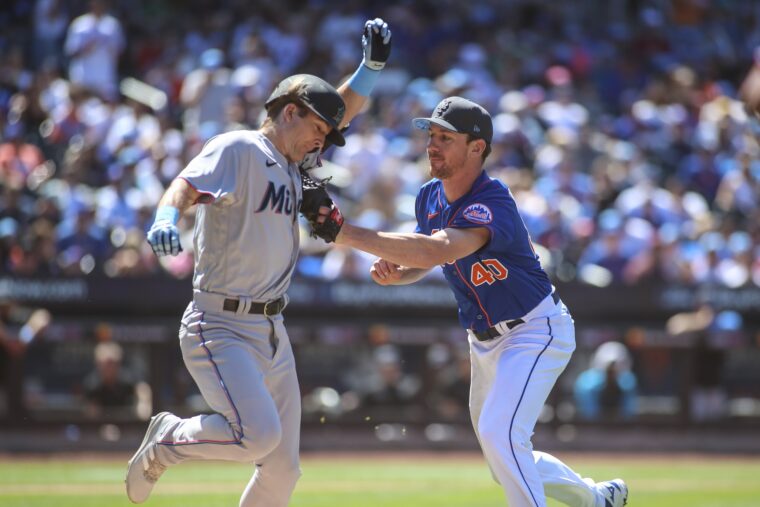
Wendell Cruz-USA TODAY Sports
On September 9, Major League Baseball announced significant rule changes that will become effective in the 2023 season. Beginning next season, there will be a pitch clock, a restriction on defensive shifting, and larger bases. Let’s take a look at some of the reactions to these modifications to the game.
First, how do the players feel about the new rules? For context, as part of the agreement that ended the lockout last offseason, a competition committee was formed, consisting of owners (six), players (four), and an umpire. The competition committee discusses rule changes, but under the new collective bargaining agreement, owners can ultimately implement rule changes with notice of 45 days to the union, a change from the prior CBA that required a year’s notice.
The process above was applied to the current round of rule changes. In a development that should surprise no one, the players’ union was not happy with the final result, saying that though they were represented in the discussions, the owners moved forward without consensus.
From Sports Illustrated, here is a statement from the Major League Baseball Players Association (MLBPA):
“Players live the game—day in and day out. On-field rules and regulations impact their preparation, performance, and ultimately, the integrity of the game itself,” the union said in a statement. “Major League Baseball was unwilling to meaningfully address the areas of concern that players raised.”
In an article published in The Athletic, Charlie Blackmon on the Colorado Rockies went a little further:
“I’m actually very against how it’s happening. It helps left-handed hitters like me. But anytime you have the boss implement something against the will of the players, that’s not good for the game of baseball. … It would be really great if we could have arrived at a conclusion together, with compromise. That would have been nice. It sounds like something we should have addressed in the (collective bargaining agreement), which, I guess is our fault as players.
Let’s turn our attention to reactions to the specific rule changes that we will see next season.
The Pitch Clock
Whether or not one agrees with its purpose, it’s indisputable that the pitch clock achieves its objective to shorten games. The clock has helped reduce the average time of a nine-inning game in the minor leagues from 3 hours, 4 minutes in 2021 to 2:38 this season. The average time of a nine-inning game in the major leagues this year is 3:06; it was 2:46 in 1989, according to the Elias Sports Bureau.
As a reminder, here is how it will work. The pitch clock will be set at 15 seconds with no runners on base and 20 seconds with runners on base. From the SI.com article cited above:
A catcher will be required to be in the catcher’s box with nine seconds left on the clock and a hitter in the batter’s box and focused on the pitcher with eight seconds remaining. Penalties for violations will be a ball called against a pitcher and a strike called against a batter.
A batter can ask an umpire for time once per plate appearance, and after that it would be granted only at the umpire’s discretion if the request is made while in the batter’s box. There will be a limit of two of what MLB calls disengagements—pickoff attempts or steps off the rubber—per plate appearance, and a balk would be called for a third or more unless there is an out. The disengagement limit would be reset if a runner advances.
From The Athletic article cited above, here are the thoughts of Dodgers’ pitcher Alex Vesia:
“I’ve asked a couple of my buddies who are in the minor leagues, and they say that it’s definitely fast. The only thing that is tough is if you’re three balls, two strikes and you don’t know what pitch you want to throw, and the clock times out. That’s ball four? You’re now predicting the game.”
While some do not favor the idea of “messing with the game,” and there is a concern of taking pitchers out of their routine and the possibility of injuries (especially to those established major leaguers to whom the clock will be new), much of the feedback on the pitch clock suggests that the games move more fluidly, and there is less “dead air,” which will hold fans’ interest.
The most intriguing part of the pitch clock rule is the limit on the number of times a pitcher can throw to a base. Get ready to see more stolen bases, as leads can get very large after two attempted pickoffs.
Shift Restrictions
Limiting shifts by requiring two infielders on each side of second base and all infielders to be positioned on the dirt will be very noticeable. Consider this from the cited article in SI.com:
Use of shifts has exploded in the past decade, from 2,357 times on balls hit in play in 2011 to 28,130 in 2016 and 59,063 last year, according to Sports Info Solutions. Shifts are on pace for 68,000 this season.
The Mets are among the teams that use the shift the most. Changing defensive rules to encourage offense is quite common in sports. The NBA eliminated zone defenses, and the NFL outlawed defensive contact with receivers beyond five yards from the line of scrimmage, to name just two.
From The Athletic article mentioned above, Gavin Lux of the Dodgers had this to say about shift restrictions:
“It makes kind of being able to be a versatile defender actually be more important and then obviously you can move the ball around, there’s more hits. From a hitter’s perspective, I like it because there’s more hits.”
Time will tell if there are more hits and fewer strikeouts with the shift modifications. Baseball has fallen into the “three true outcomes” mentality of a home run, strikeout, or walk. This may be exciting for some, and not for others.
In any case, commissioner Rob Manfred wants to see the game migrate away from this, and back to the idea of manufactured runs. Will restricting shifts bring the game to that endpoint? Manfred seems to think so.
Larger Bases
The bases will now be 18-inch squares instead of 15-inch squares. This will result in the distance between bases being reduced by four and one-half inches. The idea is to increase player safety, particularly on double plays when infielders use the base as a barrier, and to encourage more stolen bases.
If you’re going to try to encourage “small ball,” it makes sense to take this step, as stolen bases are part of that concept, and are exciting plays. However, this rule change lands a bit differently.
There does not seem to be a spate of injuries caused by runners barreling into infielders on double-plays, so what problem is MLB trying to solve? Further, is making stolen bases a little easier fair to prior base thieves such as Lou Brock and Rickey Henderson?
Think about some stolen bases that are very close and perhaps reviewed. A change of four and one-half inches can have a significant impact on successful stolen base attempts. Does this add excitement? It does. Does it also impact the record books? It probably will. In the end, if the game is more exciting and more people are drawn in, the net effect will be seen as positive.
From The Athletic, Orioles’ manager Brandon Hyde sums things up this way:
“I think it’s going to better the fan experience. I think it is going to better the player experience on the field — I’m hoping.
“The other sports have made a lot of changes in recent years and have made adjustments, and it’s nice to see our guys, the league and the players and the umpires, come together and try to better the game for the fans and the players.”
Baseball revels in its history, a wonderful history, more than other sports. However, as Hyde says, changes are always necessary. MLB is going in fairly hard on a new set of rules in 2023. Are these the right ones? That depends on the desired endpoint. In this case, increased fan interest (greater attendance and higher television ratings) is the goal.
It may take a few years, but eventually, we will see if Manfred made the correct choices.















